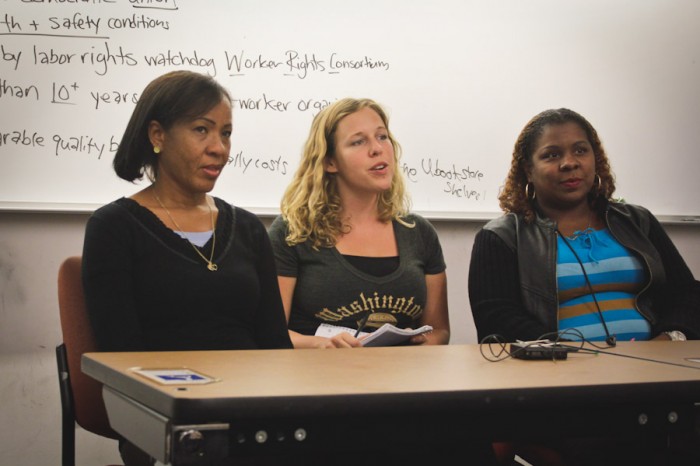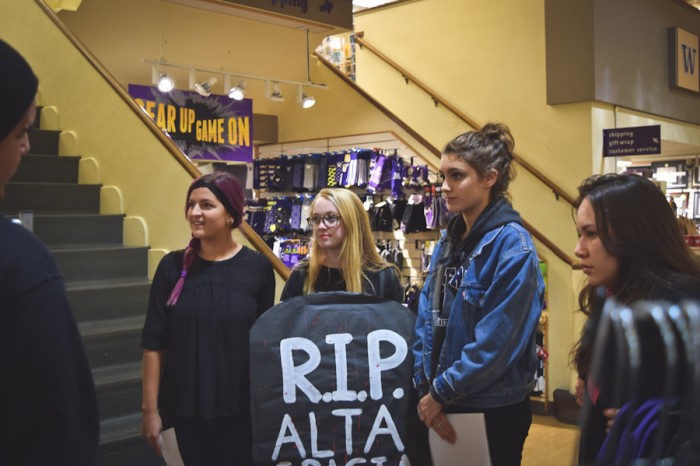
“I was subjected to all kinds of disrespect on the job — verbal and physical abuse,”
Dominican garment factory worker Sobeida Fortuna describes the eight years she spent working at the BJ&B factory that manufactured hats with university logos for Nike and Reebok.
According to Fortuna, who was in Seattle for an event organized by the UW chapter of United Students Against Sweatshops (USAS), there was only one exit for 600 workers at the BJ&B factory, no medical leave, and only two bathroom and two water breaks per shift.
When Fortuna was pregnant, she was still required to put in a 12-hour workday, with mandatory overtime hours, which she usually did not receive pay for, if the product quotas were not met.
“If we haven’t hit that production level that the management wanted, then they would just simply lock the doors…and force us to work to whatever hour in the night that was needed to actually complete the production that the management wanted,” she said through an interpreter during her visit to the UW earlier this month.
Maritza Vargas, another BJ&B worker who made the trip to Seattle, echoed similar stories about the BJ&B factory. There was no recourse and no one to go to if an employee had a problem with management. When workers decided to form a union, they were all fired. Following an investigation led by Worker Rights Consortium (WRC) and with campaigns by USAS the workers who were fired eventually got their jobs back and had a union for about six years.
But then one day in 2007 Vargas and Fortuna showed up to BJ&B for work to find it was permanently closed. The orders from major brands had been shifted to other factories in Asia, leaving the workers in Dominican Republic jobless. With the help of WRC and USAS, pregnant workers received six months severance pay, while the rest received three months of pay.
Both women now work for Alta Gracia, an alternative apparel brand offering sweatshop-free clothing to universities.
Alta Gracia opened its doors in 2010 and is owned by Knights Apparel, a company stationed in South Carolina. According to a research report from Georgetown University, “Alta Gracia: Four Years and Counting,” released back in August, it’s the only clothing factory in the developing world to pay its workers three times the minimum wage and maintain safety and health standards.
Sales aren’t too shabby either.
“Alta Gracia merchandise has performed well in the college bookstore channel. It registered approximately $11 million of retail sales in 2013 and is projected to produce $16 million in 2014,” the report stated.
Why are college students going for Alta Gracia? It’s a company that treats its workers well, showing students that they have real options in deciding which piece of clothing to buy.
The University Book Store is one of the many university stores across the nation that sell Alta Gracia apparel.
“Alta Gracia merchandise sells well, the designs and quality of the items have been important factors to their success,” said manager Karen Magarelli in an email. “We understand the new line is doing well across the country, so much so that it has caused some production and shipping delays. We’re eager to receive the rest of our order, we hope in time for holiday shopping.”
UW’s USAS, however, is unhappy with the display and amount of Alta Gracia merchandise available at the bookstore.

On Thursday, they held a rally of with about ten people at the University Book Store. They wanted to present a four and a half page letter to the bookstore’s manager stating demanding that the store stop stocking JanSport and VF Imagewear products and have more Alta Gracia apparel. According to the letter, VF Imagewear subcontracts to factories that abuse workers’ rights in Bangladesh.
“I definitely don’t think the UW bookstore is marketing Alta Gracia as well as it could be,” UW USAS member Amalia de la Iglesia said. “There are only a select few Alta Gracia products sold in the store and products made by bigger brands, like Nike and Under Armour, are put on display in the front.”
Walking into the bookstore through the main doors of the Ave, the front display does consist of mostly Nike apparel and some sale merchandise. The Alta Gracia shirts are kept closer to the register, about halfway through the store. There is one rack of two different types of long sleeved shirts costing $24.95 and about ten cubbies with four different styles of short sleeved shirts costing $17.95.
“Customer shopping patterns are our first consideration. Based on that we organize by the first three major categories: men’s, women’s, infant/child/youth,” Magarelli said, explaining how store layout decisions are made. “We include customer demand, design, quality control, and on time shipping/delivery as part of the decision process.”
As with most aspects of business, when deciding how to stock and arrange the University Book Store, it’s all about the bottom line. But Alta Gracia is proving that by appealing to college students’ demand for sweatshop free apparel, there’s plenty of room for living wages and worker’s rights in a profitable supply chain.

